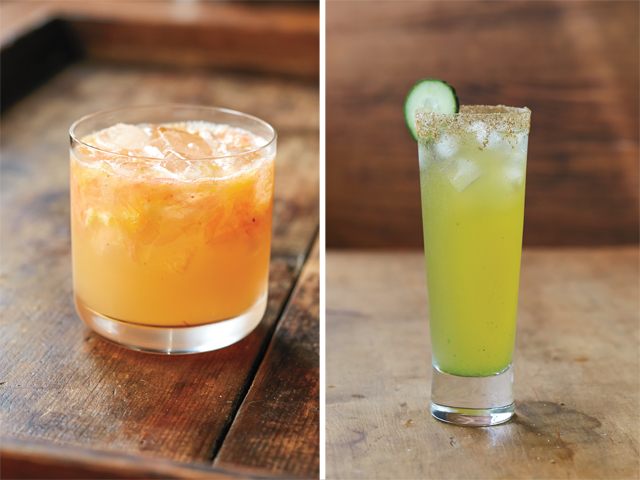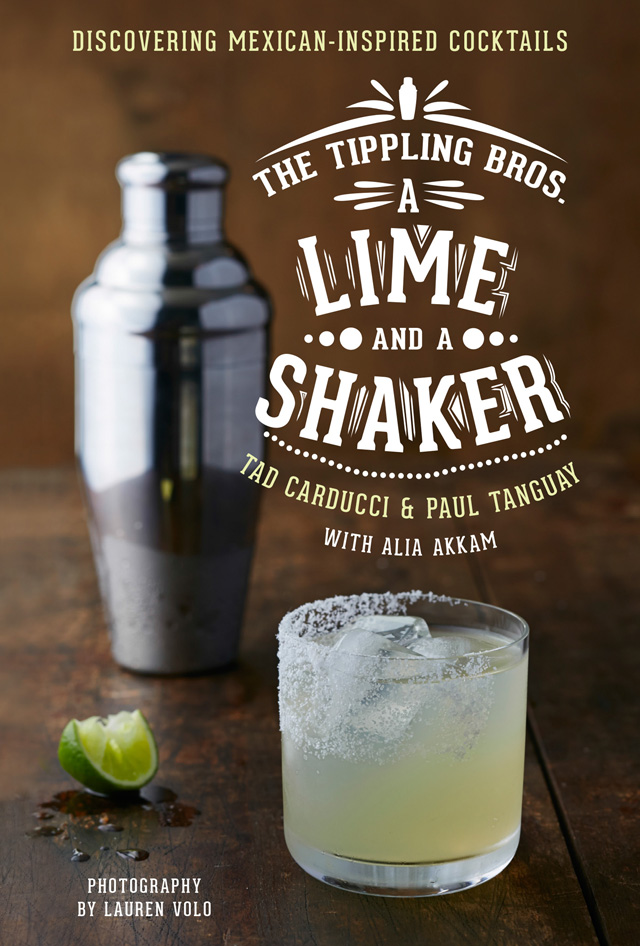Up Your Cocktail Game With This New Cocktail Book By The Tippling Bros
By Kristine Sherred in Food on Aug 7, 2015 6:15PM

Two Tippling Bros. cocktails. Left: Tres Viejos, Right: The Kermich
Paul Tanguay and Tad Carducci, a.k.a. "The Tippling Bros.", have opened or consulted on dozens of wildly successful bars across the country.
Most notably, they are partners and beverage masters of the “eclectic Mexican” Mercadito Hospitality where, since 2008, fancy fresh tacos have met their liquid match. Their cocktail book, A Lime and A Shaker, reads like an energetic bar on a Saturday night: It’s fun, fast-paced, and full of useful information.
Tanguay and Carducci start, naturally, with the Margarita. They pay due homage to our nation’s most commonly ordered cocktail (yes—it defies even the misunderstood Martini and the Old Fashioned du jour) in a brief but believable history of the drink’s origin.
Though rarely mentioned even on today’s classic-inspired menus, the original simple sour, the Daisy, is the foundation for most any cocktail with citrus. The Bros. postulate that barmen escaping the woes of Prohibition whipped up this simple cocktail while working in Mexico, swapping then traditional brandy with accessible tequila. Daisy, a common nickname for Margaret, became the Margarita.
The duo presents this and many other anecdotes in a tone simultaneously boisterous and succinct. Even the few pages dedicated to agave spirit specs and a fine brief on distilling are built not as much for spirit nerds as they are for anyone who loves a good Marg. Home enthusiasts will earn practical consumer clout, expand their tequila palate, and discover more delicious ways to savor the flavors of a beloved cuisine.
Many bar professionals test the prowess and potential of a good bar by the Mexican Daisy, on menu or not. The simplest cocktails hide no mistakes. Fresh lime and the right tequila must harmonize with exactly the right amount of sugar, or imbalance persists. There is a reason people are willing to pay upwards of $10 for a three-ingredient drink. Let the masters show you the way.
Tanguay and Carducci haven’t reinvented the sour wheel, but they offer plenty of tips and tricks. Traditionally, the Margarita was two parts blanco tequila, one part lime, and under one part orange liqueur. With the increasing presence of agave nectar (though tread carefully, as agave nectar has many dissidents and agave production has been increasingly strained since the '90s), many bars opt to omit the Cointreau and sub only agave nectar as a sweetening agent, which the duo admits they prefer to make at home. That recipe creates a sensational lip-puckering tartness that evokes the drink’s intended refreshment, but unfortunately it’s not the taste most Americans have come to know and love.
Rather than stick with one or the other, The Tipplers make a proprietary blend of what they coin “Grandma Mix”—one part simple syrup (1:1) and one part Grand Marnier —and only use a half-ounce per two ounces of tequila, an ounce of lime, and a half-ounce of agave nectar. Rim a chilled rocks glass with plenty of salt before shaking and straining over ice.

Watermelon Hibiscus Margarita
Here and there a recipe gets complicated for the mixology neophyte, but most of their recipes are pleasantly approachable. Where ingredients might trip up certain readers, they offer alternatives, as in a cinnamon sugar and salt rim instead of making cinnamon syrup. Nor do the recipes call for esoteric spirits; modifiers like sherry, amaro, and crème de cassis are procurable at well-stocked shops.
The latter half of the book, called “Craft,” digs deeper into what makes The Tippling Bros. so successful and equally essential to introducing the flavors of Latin America to the modern cocktail movement. No vodka or even gin show face in these agave-soaked pages. Each recipe stays focused on accentuating the bright, earthy, and sometimes meaty terroir of the aged agave plant, adding everything from pear puree and blackberry jam to a pineapple, kale, cilantro and ginger-spiked “super juice.”
Many specialty ingredients, like a morita chile syrup or that pear puree, are featured in multiple drinks, which helps streamline picking and choosing the menu for your next fiesta. Wowing guests won’t be tough with the addition of a blender-friendly option; try the Batida d’Uca, an energizing combination of cilantro, mango, condensed milk, orange and of course tequila.
The final section offers advice for mixing cocktails for groups (unpack that punch bowl!) and the underrated non-alcoholic side of libation. These refreshments are easy to make and easier to drink. Relax with chilled hibiscus tea spiced with orange zest and a hint of sugar, or bask in the ultimate alliance of cucumber and lemon or pineapple and ginger. 
A Lime and A Shaker
In addition to a handful of favorite food recipes, including brisket and caldo de camarones, the book pays due homage to Mexico’s real drink of preference, the Chelada. Six different recipes open up new doors from the model Worcestershire/Tabasco Michelada and its Clamato/Maggi counterpart to present multicolored alternatives like the Kermich, a green version with cucumber and hoja santa, an herb relative to eucalyptus, anise, and sassafrass. All of the recipes call for lager, though not necessarily Mexican, but always choose the time-intensive crispness proffered by the cold-fermented type of beer.
The Tippling Bros. took the taco revolution to the next level with their fresh take on some of America’s most beloved flavors in a style that has been emulated across the country. With A Lime and A Shaker, taco and Margarita lovers (and after all, who isn’t one?) can unite in the glory of real juice and 100 percent agave.